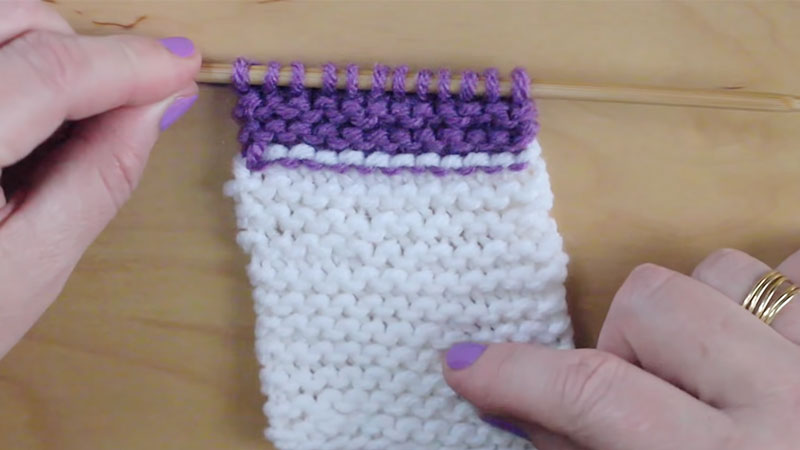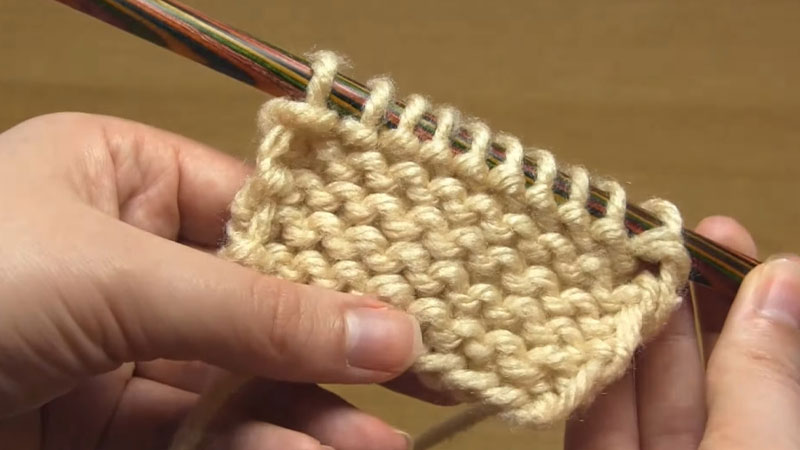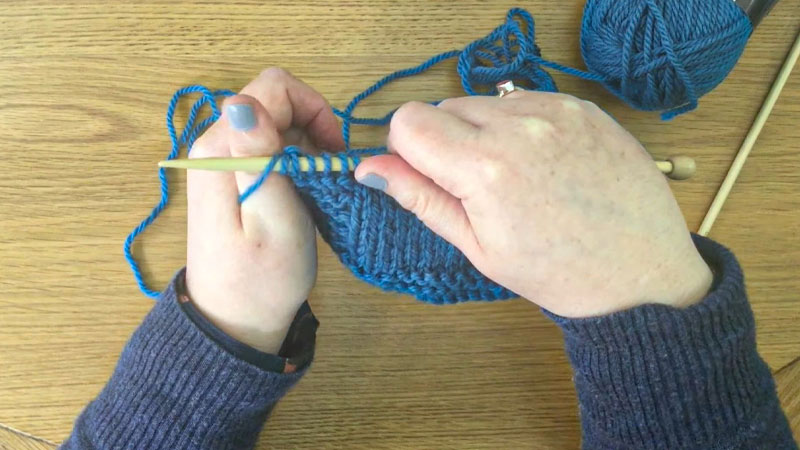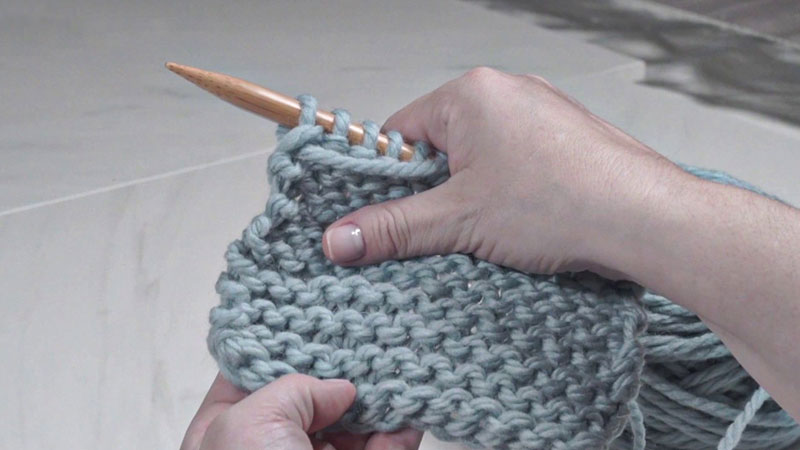In the intricate world of knitting, the abbreviation “WS” holds a pivotal role. Standing for “Wrong Side,” WS refers to the hidden, less conspicuous facet of a knitted fabric.
In contrast to the “Right Side” (abbreviated as “RS”), which is the exterior, showpiece surface, the WS resides discreetly on the interior, concealed from view.
This distinction arises from the contrast between knit and purl stitches, as the WS is often shaped by the latter, resulting in a distinct texture.
Understanding the WS is paramount in interpreting knitting patterns, ensuring seamless assembly, and achieving the desired aesthetic, making it a fundamental concept for knitting enthusiasts and artisans alike.

What Does WS Mean in Knitting? -And RS
WS in knitting is an abbreviation that stands for “Wrong Side.” The Wrong Side of a knitted fabric refers to the side of the work that is not meant to be the public or visible side of the project.
In contrast, the “Right Side” (abbreviated as “RS”) is the side of the work that is intended to be shown and is typically the more aesthetically pleasing side of the fabric.
Here are some key points to understand about what “WS” means in knitting:
Two Sides of Knitted Fabric
When you knit a piece, whether it’s a scarf, sweater, or any other item, there are typically two sides to the fabric.
The RS is the front or the side facing outward when you wear or display the finished project, while the WS is the back or the side that is hidden on the inside of the item.
Purl Stitches
The WS is often created by working purl stitches, which have a different texture and appearance than knit stitches.
While knit stitches create a smooth, V-shaped pattern on the RS, purl stitches create a bumpy, textured pattern on the WS.
Reversible Patterns
Not all knitting patterns have a distinct RS and WS. Some patterns are reversible, meaning that both sides of the fabric look the same or have a similar appearance.
This can be achieved through various stitch patterns or by using techniques like garter stitch or double knitting.
Pattern Instructions
Knitting patterns often include instructions for both the RS and WS rows or rounds. These instructions guide you on what stitches to work on each side to create the desired pattern or texture.
For example, a pattern might instruct you to “knit on the RS and purl on the WS” to create a stockinette stitch fabric.
Finishing and Assembly
Understanding which side is the WS is essential when it comes to finishing and assembling your knitting project. When seaming pieces together or adding borders, you’ll want to make sure the RS is facing out for a polished and visually appealing result.
Blocking
Blocking is the process of shaping and setting your knitting project to its final dimensions. When blocking, you may need to pin your project with the RS facing up to achieve the desired shape and size.
What Does WS Mean in Knitting Blanket?

In knitting, whether you’re making a blanket or any other project, “WS” still means “Wrong Side.” The term “WS” denotes the side of the fabric that is not intended to be the public or visible side of the item, including blankets.
When working on a knitted blanket, understanding the WS is important for several reasons:
Texture and Appearance
Many blanket patterns involve different stitch patterns or techniques that create textures or patterns.
To achieve the desired look, you may need to follow specific instructions for the RS (Right Side) and WS rows.
Reversible Blankets
Some blanket patterns are designed to be reversible, meaning that both sides of the blanket look similar or have a pleasing pattern. In such cases, the distinction between RS and WS may not be as critical.
Seaming and Assembly
When joining multiple pieces or adding borders to your blanket, it’s essential to have the RS facing out for a neat and visually appealing finish. Knowing which side is the WS helps in proper assembly.
Blocking
Blocking a knitted blanket involves shaping and setting it to its final dimensions. During blocking, you may need to arrange your blanket with the RS facing up to achieve the desired shape and appearance.
What Does Ending With a WS Row Mean?

When a knitting pattern instructs you to “end with a WS row,” it means that you should complete the final row of your project with a Wrong Side (WS) row.
This instruction is typically given to ensure that the last row you work on the project aligns with the intended pattern, texture, or finishing technique.
Here’s what “ending with a WS row” means in more detail:
Wrong Side vs. Right Side
In knitting, you have two sides to your work—the Right Side (RS) and the Wrong Side (WS).
The RS is the side of the fabric that is meant to be the public or visible side of your project, while the WS is the side that usually faces inward or is hidden.
Pattern Consistency
Some knitting patterns, particularly those with textured or patterned stitches, may require that the project finishes with a WS row to maintain the continuity of the pattern.
This ensures that the final row matches the established pattern and that the design looks consistent throughout the piece.
Finishing Techniques
In certain cases, ending with a WS row may be part of the finishing process for a project.
For example, if you’re knitting a garment that will be seamed or joined together at the end, finishing with a WS row could be essential to ensure that the seams are on the inside and not visible on the RS.
Blocking and Aesthetics
Ending with a WS row can also impact how you block and shape your project. When blocking, you may need to arrange your work with the RS facing up to achieve the desired appearance and dimensions.
What Is Wrong Side and Right Side in Knitting?

In knitting, the concepts of the “Right Side” (RS) and “Wrong Side” (WS) are fundamental to the craft, influencing the appearance and structure of your finished projects.
These terms denote the two distinct sides of the fabric you create as you work with your needles and yarn, and understanding their significance is key to following knitting patterns effectively.
Right Side (RS):
The Right Side is the front or outward-facing side of your knitted fabric. It is the side meant to be displayed or worn when your knitting project is complete.
The RS typically features the primary stitch pattern or design intended for the item you’re creating. This side is often smoother and visually appealing, making it the focus of your work.
In a basic stitch like stockinette stitch, which is a common knitting pattern, the RS consists of neat, smooth columns of knit stitches, forming a clean and uniform surface.
When you’re working on projects with intricate patterns, cables, or colorwork, the RS is where the intended design shines through. It’s the side that showcases your artistic and technical knitting skills.
Wrong Side (WS):
Conversely, the Wrong Side is the back or concealed side of your knitted fabric. This is the side not meant to be visible when your project is finished.
The WS often looks different from the RS due to the use of purl stitches or other stitch variations.
In stockinette stitch, for example, the WS reveals rows of purl stitches, which create a textured, bumpy surface.
In patterned stitches or colorwork, the WS may show floats or strands of yarn used for carrying colors, maintaining tension, or for details that aren’t meant to be seen on the RS.
How to Know Which Side Is the Right Side When Knitting?
Determining which side is the Right Side (RS) when knitting is an essential skill for following knitting patterns and ensuring your project looks its best.
Here are several methods to help you identify the RS:
Pattern Clues
Many knitting patterns will explicitly state which side is the RS at the beginning of the instructions. Look for phrases like “RS facing you” or “work on the RS” in the pattern. This is the easiest and most reliable way to identify the RS.
Initial Cast-On Tail
When you cast on your stitches at the beginning of your project, the tail of the yarn often dangles from the RS.
If you’ve forgotten which side is the RS and the pattern doesn’t specify, locate the tail, and it will usually point you toward the RS.
Stitch Appearance
Examine the stitches on your needles. In most knitting patterns, the RS features the primary stitch pattern or design, which may look different from the WS.
For instance, in stockinette stitch, the RS has smooth, V-shaped knit stitches, while the WS displays rows of bumpy purl stitches.
Texture and Pattern
When your project has a specific texture or pattern, like cables or colorwork, the RS is typically where the design stands out most prominently.
The WS may appear less defined, with floats or strands of yarn indicating color changes or cable crossings.
Row Counter or Marker
When you’re using a row counter or have placed a stitch marker at the beginning of a row, this can help you keep track of which side is the RS.
Simply position the marker on the RS at the start of your project and then follow it throughout your work.
Label or Tag
Sometimes, commercial yarns or kits come with labels or tags that indicate which side is the RS. Check any accompanying materials for guidance.
Sample Swatch
When you’ve created a gauge swatch before starting your project, you can examine it to determine which side is the RS.
Swatches are often worked with a larger border in garter stitch or another contrasting pattern on the RS side for easy identification.
Blocking
After blocking your project (reshaping and setting it to its final dimensions), the RS side usually looks neater and more polished. You can use this visual difference to confirm which side is the RS if you’re still unsure.
FAQS
What does it mean ‘ws row knitting’?
“WS row knitting” means working on the Wrong Side of the fabric, creating the side of the fabric that is not meant to be the public or visible side of the project.
Can the WS ever be the public side of a knitting project?
While the RS is typically the visible side, some reversible stitch patterns and techniques can make the WS suitable for display as well.
Do all knitting projects have a clear WS and RS?
No, some projects, like scarves in garter stitch or items in double knitting, may not have a distinct WS and RS.
Why is it important to mark the RS when knitting lace patterns?
Marking the RS in lace knitting helps ensure that the lace motifs are worked correctly, as mistakes are often harder to fix on the WS.
Can you change the RS of a knitted piece after it’s completed?
In most cases, no; the RS is determined by the stitch pattern, so changing it after the fact would require significant alterations.
Are there any specific techniques to make the WS look neater, even if it’s not the public side?
Yes, techniques like weaving in ends neatly and carrying floats carefully in colorwork can improve the appearance of the WS, even if it’s not meant to be seen.
Last Words
In knitting, the meaning of “WS” or “Wrong Side” is more than a matter of terminology; it’s a key to unlocking the artistry of this craft.
As we’ve explored, the WS represents the hidden, less visible side of a knitted piece, often characterized by texture and purl stitches.
Its significance extends beyond mere aesthetics; it informs pattern execution, assembly, and blocking techniques.
To be a skilled knitter means not only recognizing the WS but also appreciating its role in achieving the perfect finish.
Embracing both the RS and WS is where the magic of knitting truly comes to life, resulting in exquisite, well-crafted creations.
Leave a Reply